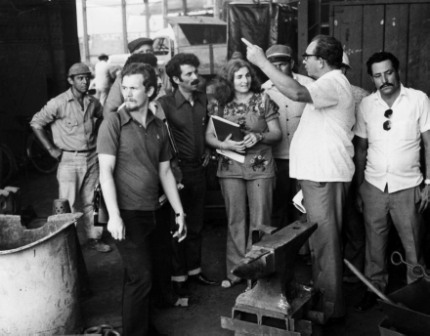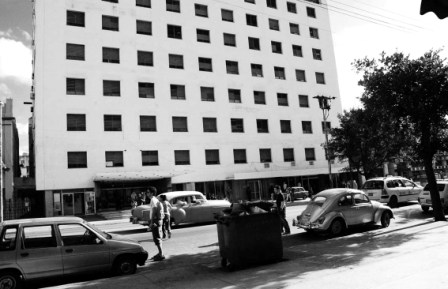Unnecessary and Sad
Final excerpt from: “To Change the World, My Years in Cuba”

HAVANA TIMES, Sept. 25 – As a poet, writer, and photographer I am most familiar with how issues of power have played themselves out within Cuba’s intellectual and artistic milieus. During my years on the island, and since, there have been times of great openness in which conflicting ideas and rich discussion were encouraged, and others of a more repressive nature in which certain groups gained control and individuals and/or categories of persons suffered greatly.
Not infrequently these repressive periods prompted great talents to leave the country, forcing them to start over in cities around the world. A terrible collective frustration, a chilling of the creative spirit, and several suicides resulted.
A succession of U.S. administrations also provoked and took advantage of the contradictions. From Operation Peter Pan (December 1960-October 1962), in which fourteen thousand Cuban children were airlifted to the United States in the wake of rumors that communism would take them from their families, to the 1980 exodus of one hundred twenty five thousand through the seaport of Mariel, these emigrations have been plagued by political intrigue on both sides; and have mostly resulted in demoralization and long term pain for all involved.
In thinking about the history, and although decidedly unfunny in retrospect, the old chicken and egg joke comes to mind. Did the increased controls respond only to pressure from the outside (as the revolution tried to make us believe) or did censorship perpetuate self censorship, creating an evolving culture of repression? Undoubtedly both scenarios were true. With the perspective of time the latter becomes more obvious.
The Cuban revolution, represented by those who stayed, has moved through a variety of attitudes toward those who choose to leave. For years the response was one of blanket repudiation. In a society where there was so little of everything, from food and medicines to housing, I think people especially resented those who’d spouted revolutionary slogans and then, from one day to the next, were packed and ready to go.
They’d kept their intentions secret until the very last moment, pretending loyalty and partaking of reward. When they left, then, it was felt as betrayal. Those who had been most vociferous in their support of the revolution drew the most ire; those who had never shown any interest were allowed to leave in peace.

The émigrés were called gusanos (worms). During one mass exodus after another those who were found to have their names on exit lists were taunted by angry neighbors, sometimes even out of control mobs. The Party tried to control this anger but was never wholly successful. Perhaps it didn’t want to be wholly successful.
In the creative world many great talents chose exile because their lifestyles, ideas or artistic expression were in opposition to or out of step with the official line. They felt cornered, menaced, suffocated, or hopeless. Homosexuals were among those most vilified and it took years for the revolution to review and rectify its treatment of those it saw as “sexually different.”
The Cuban Party subscribed to the traditional Communist idea that homosexuality was a pathology, one that did not belong within its ranks.
To keep this in perspective, at the time homosexuality was still considered pathological by the American Psychiatric Association. And many other noncommunist institutions held the same position back then. But those institutions didn’t pretend to stand for justice, and the Cuban revolution did.
This ideological distortion not only proved devastating for the country’s lesbians and gay men but kept the revolution from thinking about gender in ways that would allow for a feminist analysis of Cuban society, greatly limiting women’s self knowledge and access to power.

Religious belief was another difficult area. Early on the Catholic Church positioned itself in opposition to a revolution ideologically rooted in secularism. Some denominations actively worked against revolutionary policy.
In response the government closed the country’s religious schools. Many priests and nuns left the island. This also affected revolutionaries who held convictions of faith; they were barred from joining the Cuban Communist Party and marginalized in other ways. Jehovah’s Witnesses were declared illegal because of their refusal to do military service or allow their children to receive blood transfusions or inoculations.
Not only Catholics and some minor protestant sects but members of the African religions also suffered persecution. To add insult to injury, Cuban cultural institutions promoted Afro Cuban song and dance as authentic cultural manifestations even as they marginalized their religious practices.
Vatican II and the upsurge of liberation theology throughout Latin America eventually brought the Cuban party around to a more inclusive position on matters of faith. Cuban schools continue to offer a materialist education but a measure of accommodation with believers has been achieved.
Without public discussion or any acknowledged shift the Cuban revolution has also gradually softened its attitude toward intellectuals and artists wishing to live elsewhere. Many have been given permission to spend months or years in other countries studying or working. Those with permission can return when they wish.
Some who left without permission have also been permitted to return-to visit and very occasionally stay. Cuban artists and writers in exile have attended conferences, both on and off the island, with their counterparts who remained.
Over the years there has been a coming together that has defied the strict regulations originally imposed by the Cuban government. This softening, also largely initiated by Cuba, has been more or less visible however, depending on the moment and who may be involved. It cannot be seen as the resolution to a skewed immigration policy.
Restriction of movement, long waits for permission to come and go (in other words, immigration policy used as political coercion), and the fact that Cubans are not allowed access to the internet, are measures that have always seemed shortsighted to me, an abuse of power: unnecessary and sad.
Like the North Vietnamese separated for years from their South Vietnamese families, like the arbitrarily divided North and South Koreans, like immigrants to the United States separated by cruel immigration laws, regulations of this sort fly in the face of shared cultural roots, a global oneness and single humanity.
*Randall, Margaret. To Change the World: My Years in Cuba. Copyright © 2009 by Margaret Randall. Reprinted by permission of Rutgers University Press.
